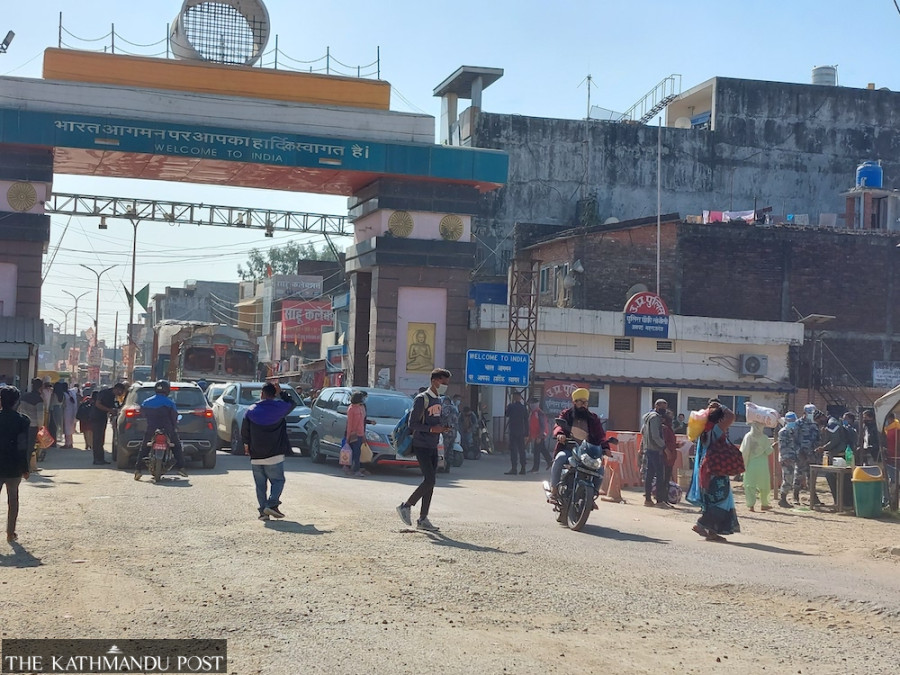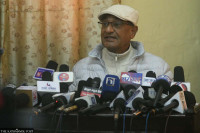National
Amid virus spread threat, provinces step up preparations
As infections rise in neighbouring India, bordering regions need extra attention, health officials say.
Sanju Paudel & Aakash Chaudhary
Nepal has reported 11,601 Covid-19-related fatalities since the pandemic began around two years ago. On May 11 last year, the country recorded the highest number of active cases at 9,317. The fragile health infrastructure of the country buckled under pressure, which robbed thousands of the chance to get timely medical attention, one of the reasons behind the daily increase in deaths.
Lumbini, one of the provinces hardest hit by Covid-19, was caught unawares by the health crisis with the active number of cases in the province peaking to 2,166 in May 2021, according to the Ministry of Health and Population.
Although the number of active cases has gone down significantly in the last few months, the province, which shares a long border with India, is still not out of the woods, say health experts.
Active cases stand at 139 in the province as of Tuesday.
“The situation can blow up any moment. People have stopped following Covid-19 safety protocols in public spaces. Large gatherings and events are being held almost every day,” Dr Sudarshan Thapa, a senior consultant physician of Lumbini Provincial Hospital, told the Post. “The border points are open to all. Therefore, the threat of the spread of the virus is high.”
According to media reports, daily cases in India have more than doubled.
The country on Wednesday reported 58,097 new Covid-19 cases, twice the number seen four days ago, taking the total to more than 35 million, Reuters reported.
The threat of the spread of the Omicron variant, which is established to be highly transmissible, is not just in Lumbini but across the country since Nepal shares a long over 1,800 km open border with India, says Thapa.
Nepal so far has reported three Omicron cases. All have already been cleared of Covid-19 now. But health authorities have warned of the continued threat of the spread of this particular variant, with S-gene target failure being reported in several infected individuals.
Government authorities in Lumbini province say the medical infrastructure of the province is stronger than in previous years.
“The institutional capacity at various Corona-designated hospitals has been increased in preparation for a possible outbreak of the coronavirus,” said Pushpa Raj Paudel, spokesperson for the provincial Ministry of Health, Population and Family Welfare.
“We have initiated preparations to control a possible outbreak of the Omicron variant in the province. The health desks set up at major border points have intensified screening and monitoring.”
According to Paudel, medical infrastructures including oxygen plants and ventilators have been increased and improved.
“The government has also provided training to pediatric doctors and nurses at various hospitals in the province on Covid-19 treatment for children,” said Paudel.
Lumbini faced an acute shortage of medical oxygen during the second wave of the pandemic which claimed scores of lives in Butwal, Nepalgunj and other places.
To avoid such a catastrophe, the oxygen production capacities of the Covid-19-designated hospitals have been enhanced after the second wave, say health officials.
“The Corona Hospital in Butwal was overwhelmed with coronavirus patients during the second wave. The shortage of oxygen exacerbated the situation,” said Dr Nandu Pathak, the focal person at the Corona Hospital in Butwal. “The hospital now has two oxygen plants with the capacity of producing 110 cylinders of oxygen on a daily basis. The Omicron variant is expected to spread rapidly in winter, and it is a highly transmissible variant. But we are prepared to handle the situation,” he said.

The province has four major Covid-19 hospitals—Corona Hospital in Butwal, Bhim Hospital in Siddharthanagar of Rupandehi, Bheri Hospital in Nepalgunj and Rapti Provincial Hospital in Tulsipur of Dang.
“The hospital is well prepared to provide treatment to Covid-19 patients. The health facility at Beljhundi and the hospital set up by Tulsipur Sub-metropolis can also be used if Covid-19 cases surge,” said Dr Binod Singh, medical superintendent at Rapti Provincial Hospital.
According to Singh, the hospital has an oxygen plant with the daily capacity of producing 75 cylinders of medical oxygen and work is under way to install two other plants at the hospital. The hospital has a total of 60 beds at the Covid-19 ward including 15 intensive care unit (ICU) beds and 15 high dependency unit (HDU) beds. “The provincial health ministry has assured to provide additional human resources if needed,” said Singh.
Preparations are also in full swing at Bheri Hospital and Bhim Hospital.
A liquid oxygen tank with a capacity of holding 20,000 litres of oxygen has been installed at Nepalgunj-based Bheri Hospital.
Bhim Hospital has installed an oxygen plant with the capacity of producing 200 cylinders of oxygen per day, according to Dr Siddhartha Pandey, the information officer at Bhim Hospital.
“We have also managed four ICU beds at the Covid-19 ward,” said Pandey. “We have been receiving around three Covid-19 patients daily. The cases might surge in the days to come so we have prepared in advance,” said Pandey.
The major checkpoints along the Nepal-India border have been kept on high alert. The health desks at Belhiya border point in Rupandehi, Krishnanagar border point in Kapilvastu and Jamunaha border point in Banke conduct health check-ups of people entering Nepal from India.
“We have instructed them to send swabs of coronavirus suspects to Teku hospital in Kathmandu,” said Paudel, the spokesperson at the provincial Ministry of Health, Population and Family Welfare.
According to the Provincial Health Directorate, the Covid-19 designated hospitals in Lumbini Province have 110 general beds, 219 HDU beds and 130 ICU beds.
So far, 1,463,914 out of a total of 3,387,128 people above 18 years of age have been fully vaccinated, according to the health directorate.
Nepal has so far vaccinated 10,597,797 people or 34.9 percent of its total population. The country needs to vaccinate over 23,400,000 people, 78 percent of its over 30 million population.
As of December 24, Nepal has received 39,203,927 doses of various Covid vaccines—Vero Cell, AstraZeneca, Moderna, Janssen and Pfizer.
Active cases across the country stand at 5,225 as of Wednesday.
Health officials in Sudurpaschim also warn of the spread of the virus if immediate measures are not taken. The province also shares an open border with India.
“The threat has not abated yet. But we are better prepared in comparison to last year. That said, there is still a lot to be done before we can say we are fully prepared to face an onslaught of the pandemic,” said Dr Gunaraj Awasthi, chief at the Health Directorate in Dhangadhi.
According to the directorate, the province has prioritised vaccination, additional infrastructure and management of human resources to control the possible outbreak of the Omicron variant.
“The vaccination drive for children aged 12 to 17 is under way. A 50-bed Covid-19 hospital is ready in Kailali and Kanchanpur districts. The provincial government has trained health workers to operate ventilators and ICU. We have administered Covid-19 vaccine to the entrants at the border points,” said Narendra Karki, the spokesperson at the Social Development Ministry.
A liquid oxygen plant with the capacity of filling 2,000 cylinders daily was installed at Mahendranagar-based Seti Provincial Hospital a few months ago. “Preparation is on to install another plant at the hospital. We are also preparing to set up an ICU facility for children,” said Hemraj Pandey, chief at the hospital.
He, however, said that the hospital only has one anaesthetist, greatly affecting the health services at the institution.

According to the health directorate, there are 12 government hospitals in Sudurpaschim Province with the capacity of 139 HDU beds, 69 ICU beds and 35 ventilators. Among them 126 HDU beds, 54 ICU beds and 21 ventilators have been arranged for the Covid-19 treatment, said the directorate.
In Province 1, another province bordering India, the local administration has increased health scrutiny at major border points. Only vaccinated foreigners are allowed to enter Nepal through the Rani border point of Biratnagar, Kakadbhitta of Jhapa, and Pashupatinagar of Ilam.
According to Kashiraj Dahal, the chief district officer of Morang, the health desk set up at the border points has been carrying out antigen tests of Covid-19 suspects.
A total of 1,136 beds have been prepared across 31 different health institutions of Province 1. According to the data available at the Social Development Ministry, there are 169 ICU beds with 117 ventilators and 357 HDU beds in the province.
All eight districts of Province 2 share their border with India. The most affected districts by the last two waves of the pandemic were Bara and Parsa.
The lack of hospitals and physical infrastructure in the past was a challenge in treating the infected but this year the province is prepared, says Vijay Jha, chief of the Provincial Health Directorate.
“Hospitals across the province are now fully prepared to treat coronavirus patients. We have added health workers and enhanced the resources,” said Jha.
The province has also expedited the vaccination campaigns, says Jha. “We will meet the target to vaccinate 66 percent of the population in the province between mid-January and mid-April,” he said.
Major hospitals such as Janakpur Provincial Hospital, Narayani Hospital and Gajendra Narayan Singh Hospital have been prepared for Covid-19 patients along with one more hospital in Mujelia, Janakpur with a 100-bed capacity.
Dr Udhay Narayan Singh, the Covid-19 coordinator of the hospital in Mujelia, said, “We have the capacity to treat 75 Covid-19 patients at a time. We have 15 HDU beds, 20 ICU beds, five beds in the isolation ward, and additional 20 beds have been kept on standby.”
The district vaccination coordination committee led by the chief district officers has been activated in all of the districts in the province. Inoculation drives are being carried out in the villages, communities and schools.
Bagmati province, where the national capital Kathmandu is, reported the first case of Covid-19 in the country back in January 2020. By May, Bagmati province was logging Covid-19 cases in the hundreds.
Dr Narendra Kumar Jha, Senior Health Administrator, Directorate of Health Services, Bagmati Province, says the province has strengthened its health infrastructure this year.
“Back then we were caught off guard. We didn’t have enough manpower or the medical equipment to provide treatment to critical cases,” said Jha. “But this time we are ready. Our hospitals have sufficient manpower; we have enough health workers in every major district hospital. We will not face a shortage of oxygen this time as oxygen plants have been installed in almost every district hospital.”
“Our health infrastructure is better than before and we are strong enough to prevent a health catastrophe,” said Jha. “Our main priority is to secure the districts connected with India and China against a new wave of Covid-19. We have set up several health desks and taken precautions such as mandating Covid-19 test on entry points and home isolation of symptomatic patients,” said Jha. “We have also prioritised vaccinating everybody above 12 years.”
The Gandaki provincial government has also prioritised vaccination and testing of suspicious persons at health desks.
“A health check post has been recently set up at Anbu Khaireni of Tanahun district. All entries must go through a health check before they enter the province,” said Dr Khim Bahadur Khadka, director at Province Health Directorate in Pokhara.
“Gandaki Province is self-dependent on medical oxygen now. Major hospitals including Pokhara Academy of Health Sciences, Manipal Hospital, Gandaki Medical College, Infectious and Communicable Disease Hospital and all the district hospitals are prepared with the necessary equipment and human resources to control Covid-19 and provide treatment to the patients,” said Khadka.
Meanwhile, Karnali Province, the country’s most remote province, is still lagging behind in its preparations against the possible surge of Covid-19 cases. The provincial executive has not taken any policy level decisions as of now. Health desks are yet to be set up at the major entry points of the province.
All the hospitals in Karnali are still plagued with a shortage of human resources and poor infrastructures. “Of the total 150 posts of health workers at the Provincial Hospital in Surkhet, 37 posts are yet to be fulfilled. It will be difficult to control the disease and provide treatment in case of a significant surge in Covid-19 cases,” said Dr Dambar Khadka, the medical superintendent at the hospital.
(With inputs from district correspondents.)




 7.12°C Kathmandu
7.12°C Kathmandu














%20(1).jpg&w=300&height=200)

